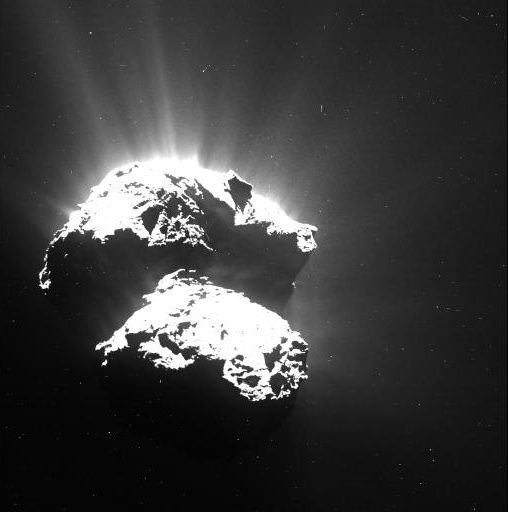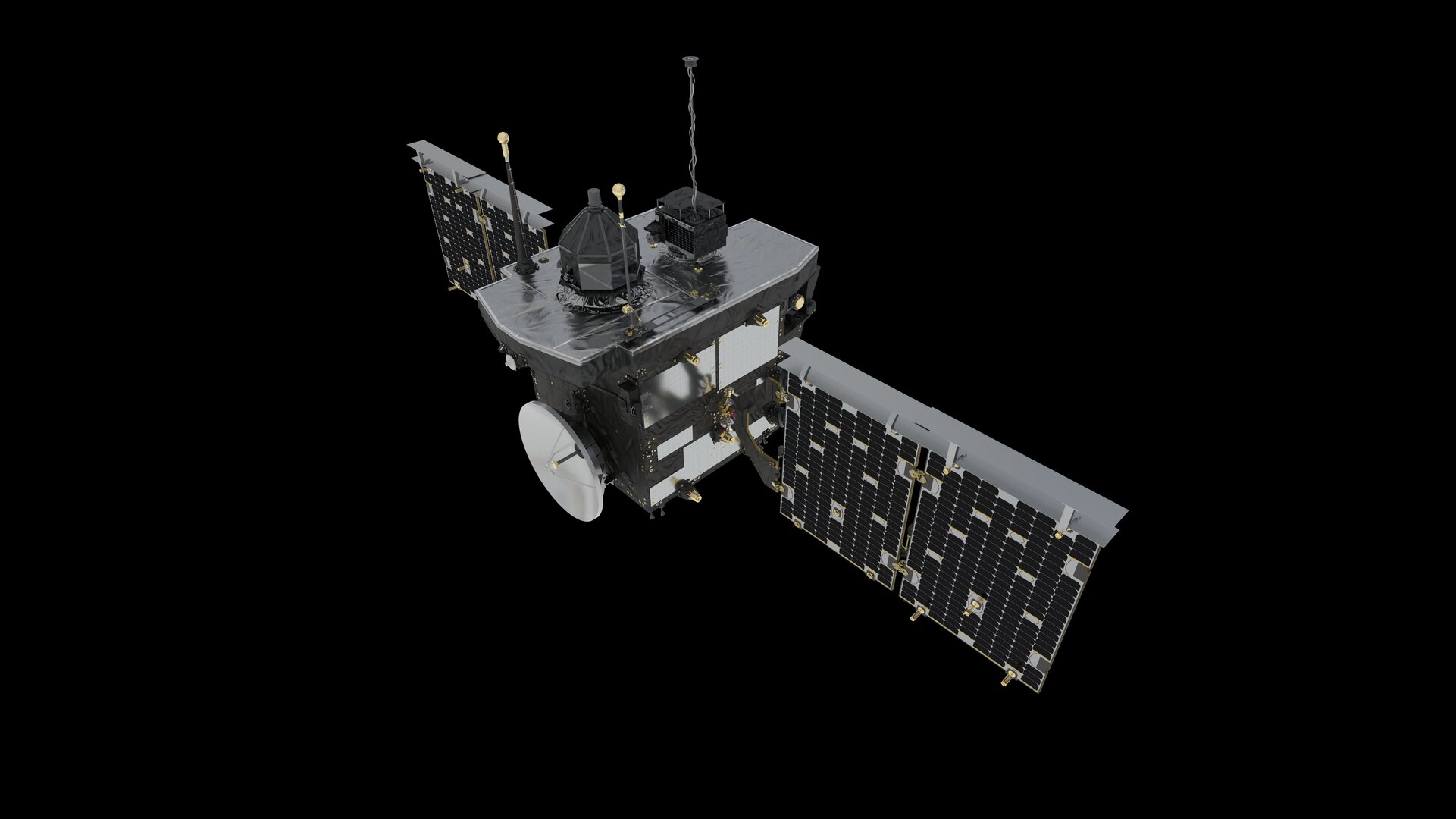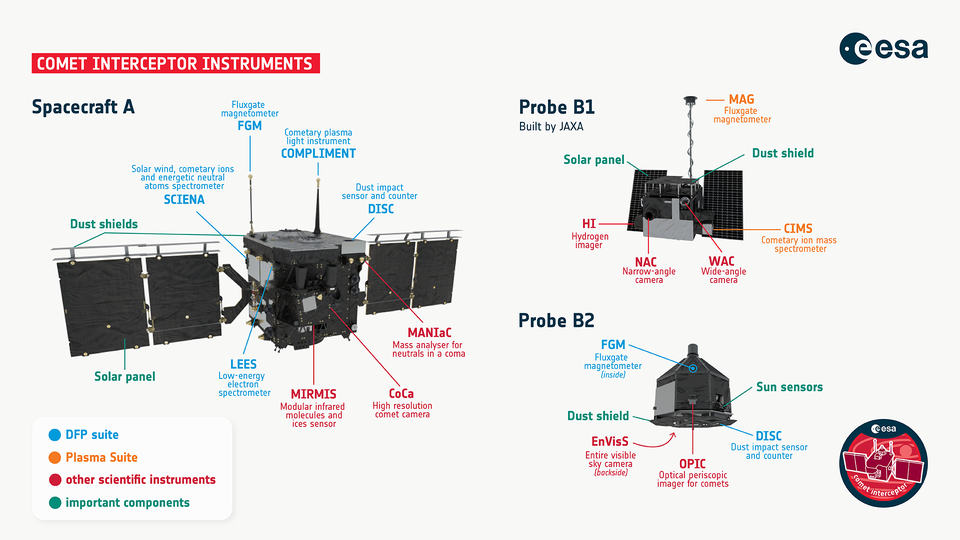Comet Interceptor's spacecraft and instruments
Comet Interceptor comprises a main spacecraft and two smaller probes. It carries a total of ten scientific instruments, each made up of one or more sensors. By taking measurements of the target comet from different locations at the same time, Comet Interceptor will construct a 3D map of the comet and the gas and dust around it.
Homing in on a comet’s icy core

When a comet enters the inner Solar System, the Sun makes it come alive. Ice in the frosty comet nucleus turns to gas, blasting jets of gas and dust into space. As a result, the nucleus is enshrouded in a hazy cloud called a coma, from which extend the long tails that comets are famous for.
This lively activity makes comets beautiful to watch, but it remains rather mysterious. To understand the processes involved, we need to take a closer look at the nucleus – the source of the gas and dust. To this end, four of Comet Interceptor’s instruments will home in on the target comet’s icy core.
The Comet Camera (CoCa) on Spacecraft A will take high-resolution images of the comet nucleus, allowing us to study its physical properties. Meanwhile, the infrared spectroscopy measurements taken by Spacecraft A’s Modular InfraRed Molecules and Ices Sensor (MIRMIS) will provide information about its chemical composition and thermal properties. They will be supported by the Narrow-Angle Camera (NAC) on Probe B1 and the Optical Periscope Imager for Comet (OPIC) on Probe B2. These cameras will image the nucleus from different directions than those of Spacecraft A, providing stereo views and increasing the fraction of the comet’s surface that can be investigated in the flyby.
Flying through a comet’s dusty exhalations
By studying the gas and dust around the comet, we learn about what compounds are contained within the comet core, and how an active comet interacts with its surroundings. All ten of Comet Interceptor’s instruments will help study the composition and behaviour of the comet’s coma and tails.
The Mass Analyzer for Neutrals in a Coma (MANiaC) on board Spacecraft A will capture atoms, molecules and small ice particles flying out of the comet to measure their mass and chemical make-up, as well as the overall gas density in the coma. At the same time, MIRMIS will study the gas composition with infrared light. In addition, the Hydrogen Imager (HI) on Probe B1 will look for UV light coming from hydrogen atoms to monitor how much water the comet spews out. Because it can measure from afar, it will be able to track the water production rate starting months before the comet flies past, until the very end of the mission.
Comet Interceptor’s ability to measure from three locations at once will allow it to make a 3D map of the dust surrounding the comet. This will be done by combining images taken by CoCa on Spacecraft A, the Wide-Angle Camera (WAC) on Probe B1, and OPIC and the all-sky imager Entire Visible Sky (EnVisS) on Probe B2. EnVisS will additionally look for polarised light to determine the size, shape and orientation of the dust particles. The Dust Impact Sensor and Counter (DISC), part of the Dust, Fields and Plasma (DFP) instrument suites present on both Spacecraft A and Probe B2, will measure the mass of dust particles.
Feeling charged up

The Sun’s radiation and solar wind (the stream of electrically charged particles coming from the Sun) charge up some of the particles flying out of a comet. As a result, the comet is also surrounded by a gas of charged particles called a plasma, which creates its own magnetic field and interacts with the charges and magnetic field of the solar wind.
The DFP instrument suites on Spacecraft A and Probe B2 and the Plasma Suite on Probe B1 are designed to study this plasma. All three instrument suites carry a magnetometer to measure the local magnetic field. Spectrometers on Spacecraft A and Probe B1 will measure the energy of charged particles in the plasma. Spacecraft A’s DFP suite also contains the COMetary Plasma Light InstruMENT (COMPLIMENT), which will measure the local electric field, the densities of electrons and ions in the plasma, UV light coming from the charged particles, the temperature of the electrons, and impacts of dust particles the size of a nanometre (a millionth of a millimetre).
Instrument overview
| Comet Interceptor's instruments | ||
| Spacecraft A | Probe B1 | Probe B2 |
|
CoCa High resolution comet camera |
NAC/WAC Narrow/wide-angle camera |
EnVisS Entire visible sky camera |
|
MANiaC Mass analyser for neutrals in a coma |
HI Hydrogen imager |
OPIC Optical periscopic imager for comets |
|
MIRMIS Modular infrared molecules and ices sensor |
PS Plasma Suite |
DFP-B2 Dust, fields & plasma instrument suite |
|
DFP-A Dust, fields & plasma instrument suite |
||
| Instrument suites | ||
| Dust, Fields and Plasma (DFP) suite on Spacecraft A |
Plasma Suite on Probe B1 |
Dust, Fields and Plasma (DFP) suite on Probe B2 |
|
FGM Fluxgate magnetometer |
MAG Fluxgate magnetometer |
FGM Fluxgate magnetometer |
|
DISC Dust impact sensor and counter |
CIMS Cometary ion mass spectrometer |
DISC Dust impact sensor and counter |
|
SCIENA Solar wind, cometary ions and energetic neutral atoms spectrometer |
||
|
LEES Low-energy electron spectrometer |
||
|
COMPLIMENT Cometary plasma light instrument |
||



